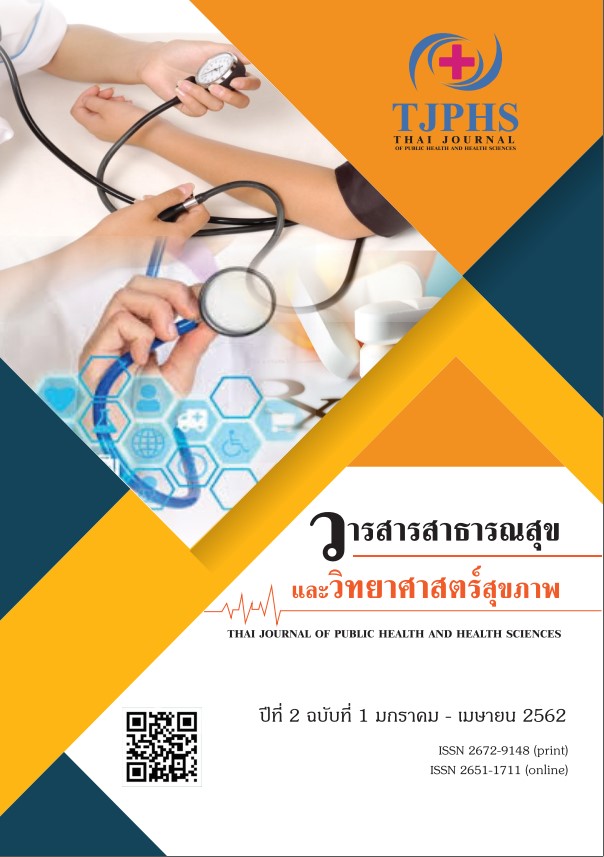การศึกษาความเป็นไปได้ในการสร้างเท้าเทียมต้นแบบสำหรับผู้ป่วยพิการขาขาด
คำสำคัญ:
เท้าเทียมชนิด SACH ผู้ป่วยพิการขาขาดบทคัดย่อ
การศึกษาความเป็นไปได้ในการสร้างเท้าเทียมต้นแบบสำหรับผู้ป่วยพิการขาขาด มีวัตถุประสงค์เพื่อศึกษาวิธีการผลิตเท้าเทียมต้นแบบสำหรับเป็นแนวทางการพัฒนากระบวนการผลิตอุปกรณ์ทางการแพทย์เพื่อทดแทนการสั่งซื้อหรือนำเข้าสินค้าจากต่างประเทศ ซึ่งในปัจจุบันเท้าเทียมเป็นอุปกรณ์ทางการแพทย์ที่มีราคาแพง (ราคาประมาณ 2,500 – 6,200 บาท) โดยงานวิจัยนี้ได้ศึกษาการผลิตเท้าเทียม ชนิด เท้าเทียมแบบข้อเข่าแข็ง SACH foot (Solid Ankle Cushion Heel Foot) เนื่องจากเท้าเทียมชนิดนี้มีต้นทุนในการผลิตที่ต่ำกว่าชนิดอื่น ๆ และสามารถใช้วัสดุประกอบที่หาได้ง่าย ซึ่งเหมาะสมกับการผลิตอุปกรณ์เทียมเพื่อนำมาใช้งานกับผู้ป่วยพิการขาขาดของโรงพยาบาลที่อยู่ในถิ่นทุรกันดารหรือหน่วยงานสนับสนุนของภาครัฐที่มีงบประมาณไม่เพียงพอสำหรับการผลิตเท้าเทียม งานวิจัยนี้ได้ออกแบบและสร้างแม่พิมพ์ด้วยปูนปลาสเตอร์เพื่อใช้ในการขึ้นรูปชิ้นงานด้วยเทคนิคการหล่อขึ้นรูป (Casting) โดยใช้วัสดุหลักในการผลิตเท้าเทียมคือ วัสดุพอลิเมอร์ชนิดโพลียูรีเทน (PU) และไม้เนื้อแข็งที่ถูกขึ้นรูปด้วยเทคโนโลยี CNC เพื่อสร้างแกนเท้าเทียม จากการประเมินราคาต้นทุนในการผลิตพบว่าเท้าเทียมต้นแบบใช้ต้นทุนการผลิตในราคา 1,896.93 บาทต่อชิ้น ทำให้ลดค่าใช้จ่ายคิดเป็นเงิน 603.07 บาทต่อชิ้น เมื่อเปรียบเทียบกับมูลค่าสินค้าที่จำหน่ายตามท้องตลาด (ราคาชิ้นละ 2500 บาท) ซึ่งทำให้มีต้นทุนในการผลิตที่ต่ำกว่าการนำเข้าสินค้าจากต่างประเทศได้
เอกสารอ้างอิง
Charoensawat, K. (2012). Properties of rigid polyurethane foam insulation in construction and the use of fire-resistant
polyurethane foam safely. Industry of Polyurethane (PUI) under the Chemical Industry Group. Retrieved October,8
2017, from polyurethanethai.com/uploads/userfiles/_1.pdf (in Thai)
Kongpueng, M. (2012). Development of metal prosthetic parts production by semi-solid metal forging. Master of
Engineering Thesis. Materials Engineering. Prince of Songkla University. (in Thai)
Lutji, C., Leiproma, W., Paoaree, C. & Sutthawatin, S. (1984). General Technician. Department of Vocational Education. (in Thai)
Ministry of Social Development and Human Security. (2017). Summary of key results of the Disability
Survey 2012. National Statistical Office. Retrieved August 29, 2017 from www.m-society.go.th/ewt_news.php?
nid=11453 (in Thai)
Phuchamnong, A., Soparat, J., Ananon, K. and Viriyaratanasak, P. (2009). Epoxy resin mold
development using the CAE technique. Academic conference The 23rd Mechanical Engineering Network of
Thailand, National Metal and Materials Technology Center. 4 - 7 November 2009. Chiang Mai. (in Thai)
Samitmaitri, P. and Chammari, U. (2011). Design of electronic artificial foot test. Research
report Faculty of Engineering Prince of Songkla University. Song Khla. (in Thai)
Tangprasert, P and Wirunsri, C. (2017). Knee prosthesis. Retrieved August 21, 2017
https://www.tpa.or.th/.../pdfFileDownloadS/tn230a_p21-23.pdf
Thai Tribune Public Free Media of the People. (2017). Ministry of Public Health Arrange the mobile prosthetic service
unit to reach the community. Retrieved August 29, 2017 from
https://thaitribune.org/ contents/detail/314?content_id=9766 (in Thai)
Thongmmak, N., Yodwanich, N., Prawatsil, S. and Wiroonsri, C.. (2013). Design and production of
ankle prototypes of artificial feet for the disabled. Academic Conference on Mechanical Engineering Projects,
Academic Year 2013. March 13, 2014. Faculty of Engineering Chulalongkorn University. Bangkok. (in Thai)
Thongruang, W., Deevayakun, C., Phatphaiboonchai, O. and Wanasin, J. (2011). Artificial foot from natural rubber.
Complete research report Prince of Songkla University. (in Thai)
Rodtuk, S. (2014). Improving the artificial foot axis in use. Master of Engineering Thesis. Industrial Engineering Chiang
Mai University. (in Thai)
ดาวน์โหลด
เผยแพร่แล้ว
รูปแบบการอ้างอิง
ฉบับ
ประเภทบทความ
สัญญาอนุญาต
บทความทุกบทความที่ได้รับการตีพิมพ์ถือเป็นลิขสิทธิ์ของ วารสารสาธารณสุข
















